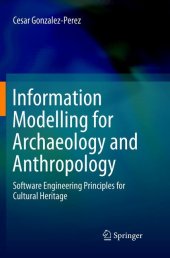 Neuerscheinungen 2019Stand: 2020-02-01 |
Schnellsuche
ISBN/Stichwort/Autor
|
Herderstraße 10
10625 Berlin
Tel.: 030 315 714 16
Fax 030 315 714 14
info@buchspektrum.de |

Cesar Gonzalez-Perez, Cesar Gonzalez- Perez
(Beteiligte)
Information Modelling for Archaeology and Anthropology
Software Engineering Principles for Cultural Heritage
Softcover reprint of the original 1st ed. 2018. 2019. xix, 449 S. 216 SW-Abb. 235 mm
Verlag/Jahr: SPRINGER, BERLIN; SPRINGER INTERNATIONAL PUBLISHING 2019
ISBN: 3-319-89193-6 (3319891936)
Neue ISBN: 978-3-319-89193-4 (9783319891934)
Preis und Lieferzeit: Bitte klicken
This unique text/reference reviews the key principles and techniques in conceptual modelling which are of relevance to specialists in the field of cultural heritage.
Information modelling tasks are a vital aspect of work and study in such disciplines as archaeology, anthropology, history, and architecture. Yet the concepts and methods behind information modelling are rarely covered by the training in cultural heritage-related fields. With the increasing popularity of the digital humanities, and the rapidly growing need to manage large and complex datasets, the importance of information modelling in cultural heritage is greater than ever before. To address this need, this book serves in the place of a course on software engineering, assuming no previous knowledge of the field.
Topics and features:
Presents a general philosophical introduction to conceptual modelling
Introduces the basics of conceptual modelling, using the ConML language as an infrastructure
Reviews advanced modelling techniques relating to issues of vagueness, temporality and subjectivity, in addition to such topics as metainformation and feature redefinition
Proposes an ontology for cultural heritage supported by the Cultural Heritage Abstract Reference Model (CHARM), to enable the easy construction of conceptual models
Describes various usage scenarios and applications of cultural heritage modelling, offering practical tips on how to use different techniques to solve real-world problems
This interdisciplinary work is an essential primer for tutors and students (at both undergraduate and graduate level) in any area related to cultural heritage, including archaeology, anthropology, art, history, architecture, or literature. Cultural heritage managers, researchers, and professionals will also find this to be a valuable reference, as will anyone involved in database design, data management, or the conceptualization of cultural heritage in general.
Dr. Cesar Gonzalez-Perez is a Staff Scientist at the Institute of Heritage Sciences (Incipit), within the Spanish National Research Council (CSIC), Santiago de Compostela, Spain.
Part I: Introduction to Conceptual Modelling
What Is Conceptual Modelling?
Premises and Foundations of Conceptual Modelling
Benefits and Applications of Conceptual Modelling
Part II: The Basics of Conceptual Modelling
Objects
Classes
Attributes
Enumerated Types
Associations
Generalization and Specialization
Recap of Part II
Part III: Advanced Conceptual Modelling
Advanced Enumerated Types
Advanced Features
Advanced Generalization
Model Architecture
Vagueness
Temporality
Subjectivity
Feature Redefinition
Metainformation
Recap of Part III
Part IV: A Model of Cultural Heritage
An Ontology for Cultural Heritage
Overview of CHARM
CHARM General Concepts
Tangible Entities
Agents
Manifestations and Performative Entities
Occurrences
Abstract Entities
Representations
Valorizations
Derived Entities
Recap of Part IV
Part V: Applying Conceptual Modelling
Modelling Patterns
Constructing Quality Models
The Modelling Process
Extending Models
Developing Database Systems
Recap of Part V
Solutions to Exercises
List of CHARM Model Elements


